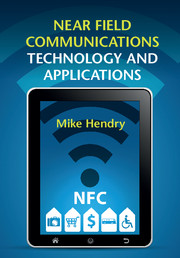1 - What is NFC?
from Part I - Introduction
Published online by Cambridge University Press: 05 December 2014
Summary
Technical standard or way of life?
Like many aspects of communications and information technology, NFC means different things to different people.
For some, it is a simple but versatile low-power interface between two devices, supported by international standards (ISO 18092 [1] / ECMA 340 [2] and ISO 14443 [3]) and an independent certification process.
Others see it as a form of user interface, allowing mobile phone users in particular to initiate applications and actions in a quick and instinctive way.
An aspect of NFC that distinguishes it from many similar communication interfaces is the infrastructure (usually called the NFC ecosystem) [4], which links service suppliers from different sectors, such as advertising, retailers, public transport, consumer electronics, mobile phone companies and payment providers, and which gives many NFC-supported applications their power.
Many people specifically associate NFC with one application (usually payment), but as we will see in this book that is too narrow a view and can actually make implementation more difficult.
NFC stands for Near Field Communication. Since about 2004 the initials have mainly been used to describe one specific set of standards and technologies that makes use of near field effects, and which can be used in mobile phones. In this book “NFC” is always used in this way, while near field communication in a more general sense (not using NFC standards) is not capitalized.
The NFC standards define a way for two devices to communicate at a short distance (a few centimetres) for a transaction that normally lasts less than a second (which is often called a “tap”). At least one of the devices is normally a mobile phone or similar device; the other may be another phone, a terminal (such as a retail point of sale or a public transport access point) or a passive device containing an antenna (commonly referred to as an NFC tag). Such passive devices may be built into advertising hoardings, information kiosks, doors and windows, or almost any object about which we want information.
Information
- Type
- Chapter
- Information
- Publisher: Cambridge University PressPrint publication year: 2014
References
Accessibility standard: Unknown
Why this information is here
This section outlines the accessibility features of this content - including support for screen readers, full keyboard navigation and high-contrast display options. This may not be relevant for you.Accessibility Information
- 1
- Cited by
